|
|
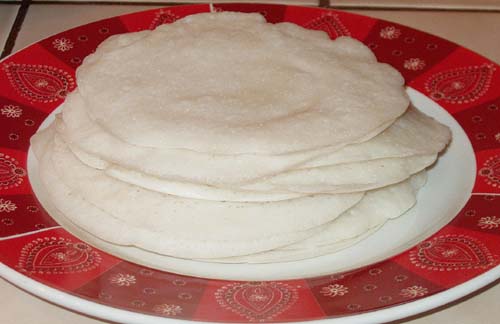 Appam, or hopper, is a rice pancake Mary, who writes the delicious blog, Mary Mary Culinary was our August Daring Cooks’ host. Mary chose to show us how delicious South Indian cuisine is! She challenged us to make Appam and another South Indian/Sri Lankan dish to go with the warm flat bread.
Total time: 12-16 hours.
Ingredients:
1 ½ cups (360 ml/300 gm/10½ oz) raw rice
1 ½ teaspoons (7½ ml/5 gm) active dry yeast
2 teaspoons (10 ml/9 gm) sugar
½ cup (120 ml) of coconut water or water, room temperature
1 ½ tablespoons (22½ ml/18 gm) cooked rice
½ teaspoon (2½ ml/3 gm) salt
about ½ cup (120 ml) thick coconut milk (from the top of an unshaken can)
Directions:
 My edges weren't thin all the time, but it still worked out. 1. Soak the raw rice in 4 to 5 cups of water for 3 hours. I kept forgetting to do this, so I soaked overnight. Worked great. 😉
2. Dissolve the sugar in the coconut water or plain water and add the yeast. Set aside in a warm area for 10-15 minutes, until very frothy.
3. Drain the rice and grind it in a blender with the yeast mixture to make a smooth batter. You can add a bit of extra water if needed, but I did not. Add the cooked rice, and grind/blend to combine well.
4. Pour into a large bowl, cover and leave in a warm place for 8-12 hours. You not only want the mixture to rise and collapse, but to ferment. When it is ready, it will have a slightly sour and distinctly yeasty smell. Don’t worry–they are mild tasting when cooked!
5. Add the coconut milk and salt, and a bit of water if necessary, so that you have a batter that is just a bit thicker than milk. Notice how it bubbles after you add the coconut milk. I recommend test-cooking one before thinning the batter.
6. Heat your pan over medium heat. Wipe a few drops of oil over it using a paper towel. Stir the batter and pour in 3-4 tablespoons, depending on the size of the pan. Working quickly, hold the handle(s) and give the pan a quick swirl so that the batter comes to the top edge. Swirl once only, as you want the edges to be thin and lacy.
7. Cover the pan and cook for about 2 minutes. Uncover and check. The center should have puffed up a bit, and will be shiny, but dry to the touch. When ready, loosen the edges with a small spatula and serve immediately. These need to be served hot out of the pan.
The leftover batter can be refrigerated for a day or 2.
Wow. These are new and amazing to me, and I will be making them again and again. I enjoyed them so much, I was looking around for more.
 Sri Lankan Curry with pork Mary, who writes the delicious blog, Mary Mary Culinary was our August Daring Cooks’ host. Mary chose to show us how delicious South Indian cuisine is! She challenged us to make Appam and another South Indian/Sri Lankan dish to go with the warm flat bread.
Total time: 1.5 hours.
1 pound (½ kg) boneless meat, or about 1 ½ pounds (¾ kg) short ribs or cross ribs (or boneless lamb shoulder) I used pork!
1 tablespoon (15 ml) vegetable oil
10 fresh or frozen curry leaves
1-3 green cayenne chili, finely chopped
generous 1 cup (250ml/250 gm/9 oz) finely chopped onion
1 teaspoon (5 ml/3 gm) turmeric
1 teaspoon (5 ml/6 gm) salt
½ cup (120 ml) coconut milk
1 tablespoon (15 ml/15 gm) tamarind pulp
¼ cup (60 ml) hot water
1/4 cup tamarind paste
3 cups (720 ml) water
Dry Spice Mixture:
1 tablespoon (15 ml/13 gm) raw white rice
1 tablespoon (15 ml/10 gm) coriander seeds
1 teaspoon (5 ml/4 gm) cumin seeds
one 1-inch piece (2½ cm) cinnamon or cassia stick
seeds from 2 pods of green cardamom
Directions:
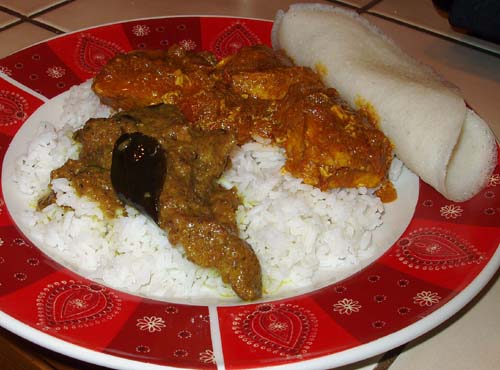 Sri Lankan Curry with pork and hot curried chicken, with rice and appam 1. Cut the meat into ½ inch (13 mm) cubes or separate the ribs. Set aside.
2. In a small heavy skillet, roast the dry spice mixture over medium to medium-high heat for 3 to 4 minutes, stirring continuously, until it smells amazing! You will be able to see that the rice is a toasted color.
3. Transfer to a spice grinder or mortar and grind/pound to a powder. Set aside.
4. In a large, wide pot, heat the oil over medium-high heat. Add the curry leaves, green chile, onion and turmeric and stir-fry for 3 minutes. I cooked my onions until they were golden brown. So good. Add the meat and salt and cook for 5 minutes, stirring occasionally so all surfaces of the meat get browned.
5. Add the reserved spice mixture and the coconut milk and stir to coat the meat. Reduce the heat to medium and cook for 10 minutes, stirring occasionally.
6. Add the tamarind paste to the 3 cups of water.
7. Add the tamarind/water mixture to the pot and bring to the boil. Reduce the heat and cook uncovered at a strong simmer for about an hour, until the meat is tender and the flavors are well blended. Taste and adjust the seasoning. Serve hot.
Shown here with hot curried chicken, rice, and an appam.
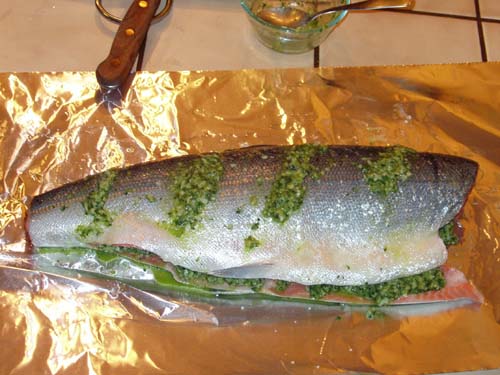 Raw Goan Fish, ready for foil and grilling Mary, who writes the delicious blog, Mary Mary Culinary was our August Daring Cooks’ host. Mary chose to show us how delicious South Indian cuisine is! She challenged us to make Appam and another South Indian/Sri Lankan dish to go with the warm flat bread.
One 2-pound (1 kg) firm fish, such as pickerel, trout or red snapper, cleaned and scaled – I used pink salmon
about ¼ cup (60 ml) vegetable oil
about 8 fresh curry leaves – I didn’t know where to use these, so I skipped it
2 tablespoons (30 ml) fresh lime juice
1 tablespoon (15 ml/18 gm) fine sea salt
½ cup (120 ml/110 gm) Fresh Green Chile Chutney, plus extra to serve as a condiment
Preheat your grill or start your charcoal.
Wash and dry the fish. Cut slits every three to four inches along each side of the fish. Grease a large stretch of foil 3 tablespoons (45 ml) of the oil.
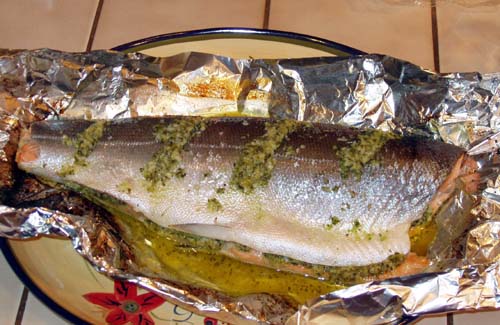 Goan Fish, fresh off the grill with lots of juice! Rub the fish inside and out with the lime juice, then with the salt. Stuff some of the chutney into the slits you made, and put the rest in the belly cavity. Place the fish on the oiled foil and rub the remaining oil over it. Wrap the fish tightly, using more foil if necessary.
Move your charcoal to one side of the grill or turn off the heat on one side of your grill. Place your foiled fish on the “off” side and close the lid. Grill 20-30 minutes, depending on the size of your fish (10 minutes per pound), keeping the heat at 400F or above. Depending on the size of your grill, you may need to rotate your fish halfway through.
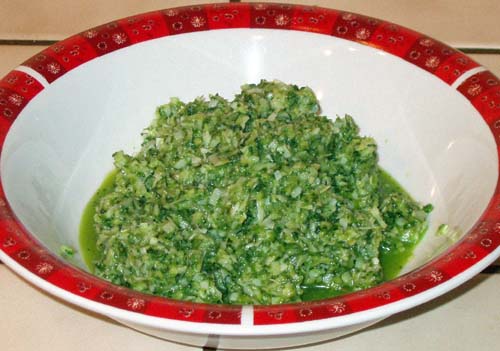 Fresh Green Chile Chutney Mary, who writes the delicious blog, Mary Mary Culinary was our August Daring Cooks’ host. Mary chose to show us how delicious South Indian cuisine is! She challenged us to make Appam and another South Indian/Sri Lankan dish to go with the warm flat bread.
Total time: 15 minutes.
Ingredients:
2 cups (480 ml/120 gm/4¼ oz) packed cilantro (coriander) leaves and stems
6 green cayenne chiles, coarsely chopped
6-10 medium garlic cloves, chopped
2 teaspoons (10 ml/6 gm) minced peeled ginger
about 1 cup (240 ml/80 gm/2¾ oz) fresh or frozen grated coconut
1 teaspoon (5 ml/3 gm) cumin seeds, coarsely ground
3 tablespoons (45 ml) fresh lime juice
1 teaspoon (5 ml/4½ gm) sugar
1 teaspoon (5 ml/6 gm) salt, or to taste
Directions:
1. In a food processor, combine the cilantro, chiles, garlic and ginger and process to a paste. Add the coconut and process until blended. Transfer to a bowl.
2. Add the cumin, lime juice, salt and sugar and mix well. Taste for seasoning (it will be hot!). Keeps for about 4 days refrigerated.
 Cauliflower Curry on rice Total time: Approximately 1.5 hours.
Adapted from 1,000 Indian Recipes by Neelam Batra.
1 large cauliflower, washed
3 Tbsp vegetable oil
~1 tsp salt
1 medium onion, coarsely chopped
8 quarter-size slices fresh, peeled ginger
2 tsp minced garlic
1 to 3 serrano peppers
2 large tomatoes, coarsely chopped
1/2 c plain yogurt, whisked until smooth
1 c water
1/4 tsp ground nutmeg
1 1/2 tsp ground coriander
1 tsp ground cumin
1/2 tsp garam masala + 1/4 tsp for garnish
1/4 tsp ground turmeric
1/2 c finely chopped fresh cilantro
Peel away the leaves at the stem of the cauliflower. Wash the head of cauliflower and trim away any brown spots by scraping them off with your knife. Turn the cauliflower on its head and cut from the stalk to the florets in one big slice, creating two halves.
Remove the fibrous outer coating of the stalk, but keep the softer insides. In a food processor or blender, combine the soft stalk pieces, onion, ginger, garlic and serranos until mostly smooth. Set aside.
Puree tomatoes, set aside.
Chop remaining cauliflower into bite size florets. In a small, microwave safe container, toss florets with 1 Tbsp of oil and sprinkle lightly with 1/4 tsp of salt. Microwave on high 3 minutes. Transfer to a large frying pan or wok and cook over medium-low heat until pieces are mostly brown on all sides. Remove florets to a bowl, but keep the heat on.
Add remaining 2 Tbsp of oil to the pan. Add onion mix and cook over medium-high heat until mostly brown, stirring occasionally. Add tomatoes and cook 8-10 minutes, until most of the juice is absorbed and a nice oily sheen appears. Add seasonings and cook 1-2 minutes more.
Reduce heat to low. Slowly add water and yogurt, stirring constantly until well incorporated. Turn heat back up to medium, add cauliflower back into the pan, mix well and cover. Let simmer 20-30 minutes until cauliflower is tender.
Add cilantro and remaining garam masala just before serving.
In case you hadn’t guessed, cauliflower = dinosaur bones. I challenge you to come up with a more clever way to get a toddler to eat cauliflower.
I liked this a lot, but we decided it was just a lot of cauliflower for a main course. So I’ve relegated this to a side dish, and I probably won’t make it again unless I know I have company that’s either 1. mostly vegetarian and/or 2. loves cauliflower.
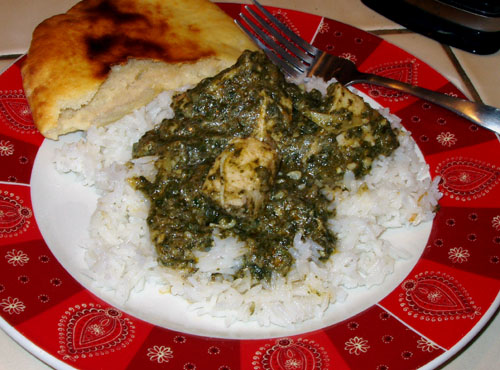 Chicken Saag with rice and naan Total time: Approximately 1 hour and 20 minutes.
Adapted from 1,000 Indian Recipes by Neelam Batra.
2-4 chicken breasts, quartered
2 small bunches fresh spinach, coarsely chopped
1 large onion, coarsely chopped
4 quarter-sized peeled fresh ginger root + one 1-inch piece peeled fresh ginger root, julienned
3 large cloves fresh garlic, peeled + 1 clove minced
1/4 c water
1/4 c plain yogurt, whisked until smooth
2 Tbsp vegetable oil
1 Tbsp melted ghee (or butter)
2 Tbsp butter, at room temperature
1 large cinnamon stick (about 3 inches)
5 green cardamom pods, crushed lightly to break the skin
1-4 whole dried red chile peppers, such as chile de arbol (optional)
1 Tbsp ground coriander
1 tsp garam masala
1 tsp dried fenugreek leaves
1/2 tsp ground paprika
1/2 tsp salt, or to taste
On medium heat, cook chicken pieces until they turn white on all sides (or lightly browned) and the juices run clear (about 5 minutes, depending on how big your chicken chunks are). Set aside.
In a large pan, bring spinach, onion, ginger slices, whole garlic and water to a boil. Reduce heat to medium-low and simmer, covered, until the spinach is wilted (about 10 minutes). Remove from heat and let cool 5-10 minutes. Pulse lightly in a food processor until just minced (don’t make a puree!!). Return the spinach mix to the pan.
In a small pan, heat the oil and ghee on medium-high. Add the cinnamon, cardamom, and julienned ginger, stirring until the ginger sticks turn golden brown (about 3 minutes). Add the minced ginger, coriander, garam masala, fenugreek, and salt and quickly stir. Slowly add the yogurt (one dollop at a time), stirring constantly to blend it in with the spices.
Immediately after adding all the yogurt, add the entire yogurt spice mix to the spinach mix. Add chicken pieces to spinach mix, cover and simmer on medium-low for 25-30 minutes.
In a small pan, heat the remaining butter and cook the dried chiles for about a minute. Remove from heat, stir in the paprika, then lightly swirl into the spinach mix just before serving. (If you’re doing without chiles, just sprinkle the top of the dish with some paprika before serving.)
Shown here with homemade naan and plain white rice.
You might want to pick out the cinnamon stick and cardamom pods before you serve this dish so someone doesn’t try to eat them; that’d be rather unpleasant.
I crushed my red peppers before putting them in the frying pan.
This recipe dirties up a lot of dishes. You could cut back on them by reusing your chicken frying pan to fry your spices, and you could probably skip the butter-frying of your peppers at the end, too. Just omit the butter entirely and add the peppers and paprika straight to the dish.
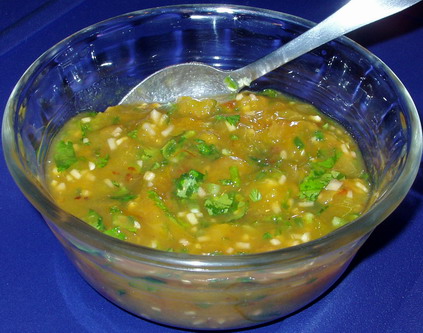 Plum and Ginger Chutney Total time: 10 minutes, depending on your fruit.
Adapted from “Pureed Fresh Mango-Ginger Chutney” in 1000 Indian Recipes, by Neelam Batra.
1 pound of plums, washed, peeled, pitted and diced
1 Tbsp peeled and minced fresh ginger root
2 Tbsp lemon juice (or lime)
2 Tbsp finely chopped fresh cilantro, including soft stems
1 serrano pepper, minced with seeds
salt and pepper to taste
Mash the plums with a fork or potato masher to make the fruit as smooth as possible.
Mix in all the remaining ingredients.
Keep up to 1 week in the refrigerator.
Some of the Daring Cooks used a plum chutney with their September Challenge, which made me want to try it, too. Then a friend brought me some fresh plums from her tree, and I knew it was meant to happen. I didn’t use the same recipe as the other folks, though. I love my book of Indian recipes, and I like to make them adapt!
The original recipe calls for mashed mango, and suggests mixing in 1/2 c yogurt or substituting peaches, plums, nectarines, pineapples or other soft fruit in place of mango.
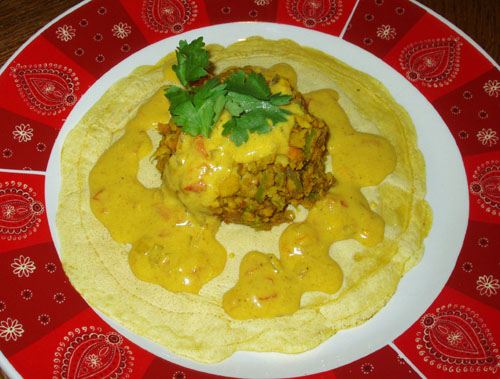 Vegetable dosa with coconut curry sauce The Daring Cooks‘ September challenge comes from Indian Dosas from the reFresh cookbook by Ruth Tal and Fresh Restaurants.
This filling works great as a rice bowl topping or as a wrap too, so don’t be afraid to make a full batch. Can substitute potatoes for chickpeas.
Total time: Approximately 30 minutes.
5 cloves garlic
1 onion, peeled and finely diced
1 carrot, peeled and finely diced
1 green pepper, finely diced (red, yellow or orange are fine too)
2 medium hot banana chilies, minced
2 TBSP (16gm) cumin, ground
1 TBSP (8gm) oregano
1 TBSP (8gm) sea salt (coarse)
1 TBSP (8gm) turmeric
4 cups (850gm/30oz) cooked or canned chick peas (about 2 cans)
½ cup (125gm/4oz) tomato paste
1.Heat a large saucepan over medium to low heat. Add the garlic, veggies, and spices, cooking until soft, stirring occasionally.
2.Mash the chickpeas by hand, or in a food processor. Add the chickpeas and tomato paste to the saucepan, stirring until heated through.
Shown here served inside Instant Flour Dosas, topped with Coconut Curry Sauce.
Total time: 20 minutes.
1 cup (120gm/8oz) spelt flour (or all-purpose, gluten free flour)
½ tsp (2½ gm) salt
½ tsp (2½ gm) baking powder
½ tsp (2½ gm) curry powder
½ cup (125ml/4oz) almond milk (or soy, or rice, etc.)
¾ cup (175ml/6oz) water
cooking spray, if needed
1.Combine the dry ingredients in a bowl, slowly adding the almond milk and water, whisking until smooth.
2.Heat a nonstick skillet over medium heat. Spray your pan with a thin layer of cooking spray, if needed.
3.Ladle 2 tablespoons of batter into the center of your pan in a circular motion until it is a thin, round pancake. When bubbles appear on the surface and it no longer looks wet, flip it over and cook for a few seconds. Remove from heat and repeat with remaining batter. Makes 8 pancakes.
Total time: 50 minutes.
1 onion, peeled and chopped
2 cloves garlic
½ (2½ gm) tsp cumin, ground
¾ (3¾ gm) tsp sea salt (coarse)
3 TBSP (30gm) curry powder
3 TBSP (30gm) spelt flour (or all-purpose GF flour)
3 cups (750ml/24oz) vegetable broth
2 cups (500ml/24oz) coconut milk
3 large tomatoes, diced
1.Heat a saucepan over medium heat, add the onion and garlic, cooking for 5 minutes, or until soft.
2.Add the spices, cooking for 1 minutes more. Add the flour and cook for 1 additional minute.
3.Gradually stir in the vegetable broth to prevent lumps. Once the flour has been incorporated, add the coconut milk and tomatoes, stirring occasionally.
4.Let it simmer for half an hour.
|
|











